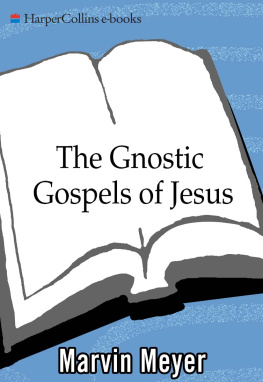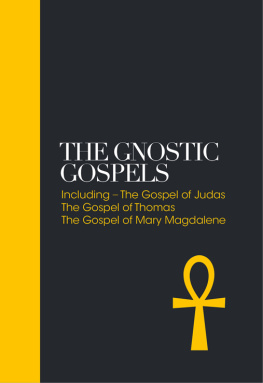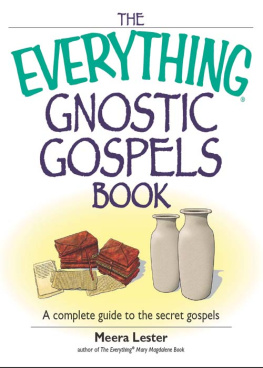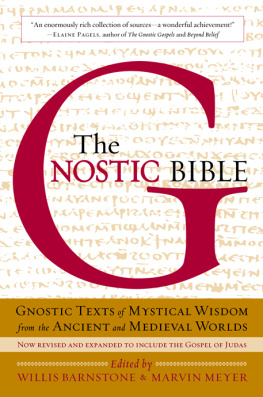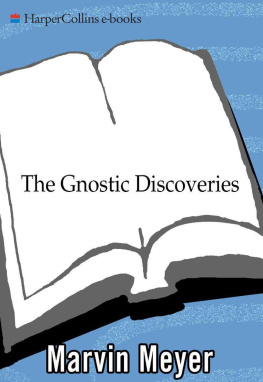CONTENTS
James M. Robinson
Marvin Meyer and Elaine H. Pagels
Madeleine Scopello and Marvin Meyer
Madeleine Scopello and Marvin Meyer
Einar Thomassen and Marvin Meyer
Einar Thomassen and Marvin Meyer
Einar Thomassen
John D. Turner and Marvin Meyer
Marvin Meyer
Madeleine Scopello and Marvin Meyer
Marvin Meyer
Marvin Meyer
Madeleine Scopello and Marvin Meyer
John D. Turner and Marvin Meyer
John D. Turner and Marvin Meyer
Madeleine Scopello and Marvin Meyer
Madeleine Scopello and Marvin Meyer
Madeleine Scopello and Marvin Meyer
Madeleine Scopello and Marvin Meyer
Wolf-Peter Funk
Wolf-Peter Funk
Madeleine Scopello and Marvin Meyer
Madeleine Scopello and Marvin Meyer
Paul-Hubert Poirier and Marvin Meyer
Madeleine Scopello and Marvin Meyer
Madeleine Scopello and Marvin Meyer
Marvin Meyer
Jean-Pierre Mah and Marvin Meyer
Jean-Pierre Mah and Marvin Meyer
Jean-Pierre Mah and Marvin Meyer
Michel Roberge
Marvin Meyer
Marvin Meyer
Birger A. Pearson
John D. Turner
John D. Turner
Marvin Meyer
Birger A. Pearson
John D. Turner and Marvin Meyer
Birger A. Pearson
John D. Turner
Einar Thomassen
Einar Thomassen and Marvin Meyer
John D. Turner
John D. Turner and Marvin Meyer
Paul-Hubert Poirier and Marvin Meyer
John D. Turner
Karen L. King
Marvin Meyer
Marvin Meyer
Marvin Meyer
Marvin Meyer
John D. Turner
Einar Thomassen
Jean-Pierre Mah
EDITED BY
MARVIN MEYER
WITH CONTRIBUTIONS BY
Wolf-Peter Funk, Karen L. King, Jean-Pierre Mah, Marvin Meyer,
Elaine H. Pagels, Birger A. Pearson, Paul-Hubert Poirier, Michel Roberge,
James M. Robinson, Madeleine Scopello, Einar Thomassen,
and John D. Turner
BASED ON THE WORK OF
the Berliner Arbeitskreis fr koptisch-gnostische Schriften,
the Bibliothque copte de Nag Hammadi, Universit Laval, and
the Coptic Gnostic Library Project, Institute for Antiquity
and Christianity, Claremont Graduate University
ADVISORY BOARD
Wolf-Peter Funk
Paul-Hubert Poirier
James M. Robinson

THE NAG HAMMADI SCRIPTURES . Copyright 2007 by Marvin Meyer. All rights reserved under International and Pan-American Copyright Conventions. By payment of the required fees, you have been granted the non-exclusive, non-transferable right to access and read the text of this ebook on-screen. No part of this text may be reproduced, transmitted, down-loaded, decompiled, reverse engineered, or stored in or introduced into any information storage and retrieval system, in any form or by any means, whether electronic or mechanical, now known or hereinafter invented, without the express written permission of HarperCollins ebooks.
FIRST HARPERCOLLINS PAPERBACK EDITION PUBLISHED IN 2009
Library of Congress Cataloging-in-Publication Data is available upon request.
ISBN 9780061626005
08 09 10 11 12 RRD(H) 10 9 8 7 6 5 4 3 2 1
EPub Edition JUNE 2013 ISBN: 9780062046369
T O
H ANS -M ARTIN S CHENKE
19292002
Esteemed colleague, dear friend,
Coptologist extraordinaire
James M. Robinson
T he Nag Hammadi Scriptures is a collection of thirteen papyrus codicesbound books, not scrollsthat were buried near the city of Nag Hammadi in Upper Egypt most likely in the second half of the fourth century CE . They had been brought together earlier in that century and then buried in a jar for safekeeping at the foot of the Jabal al-Tarif, a cliff close to the hamlet Hamra Dum. In all, there are some fifty-two tractates in the collection of Nag Hammadi codices, and since six are duplicates, there are forty-six different texts. Of these, forty-one are texts that were not previously extant, but ten are very fragmentary, so that one may say that the discovery has added about thirty-one new texts to our knowledge of religion and philosophy in antiquity. This is indeed a dramatic escalation of source material on early Christian, Neoplatonic, Hermetic, Sethian, and Valentinian thought. The precise dates of the composition of these texts are uncertain, but most are from the second and third centuries CE . All were originally written in Greek and translated into Coptic.
The people who wrote, copied, translated, recopied, read, collected, and finally buried these texts are unknown. Since most of the tractates are Gnostic, it is assumed that there must have been a sympathetic community in the region that collected, cherished, and then buried its library. The cartonnagethe discarded papyrus used to thicken the inside of the leather coverscontains references to the region near where they were discovered and dates on receipts just before and in the middle of the fourth century. Thus, the time and place of the production of the codices coincides with the emergence of the Pachomian monastic order, with which there may be some association. In fact, fragments of a Coptic letter from a Papnoute to a certain Pahome may be from Papnoutios, the business manager of the nearby monastery, to its founder, Pachomius. In 367, Athanasius, the orthodox patriarch of Alexandria, wrote an Easter letter to be read in all the monasteries of Egypt, calling upon them to eliminate from their libraries apocryphal writings; in the letter he listed those books that were to be included as acceptablethe oldest extant list of the twenty-seven books in the New Testament. It has been suggested that the Nag Hammadi codices were among the books that had to be excluded but were buried for safekeeping in a sealed jar by those who valued them.
Another codex, Papyrus Berolinensis 8502, which has been in Berlin for a century, contains duplicates of two tractates in the Nag Hammadi collection, the Secret Book of John and the Wisdom of Jesus Christ , as well as two other texts, the Gospel of Mary and the Act of Peter . They have been included in the present edition, as have the texts from Codex Tchacos, the Gospel of Judas and the Book of Allogenes .
The English translation of the Nag Hammadi scriptures published in the present volume is the result of the close collaboration of three teams of scholars who over the past generation have prepared English, French, and German translations. The English-language team has had its center in the Coptic Gnostic Library Project of the Institute for Antiquity and Christianity of Claremont Graduate University in Claremont, California. It was first to publish a preliminary translation of the whole discovery, The Nag Hammadi Library in English , in 1977, in order to make the tractates available promptly to a wider audience. The Claremont team published a critical edition of the Nag Hammadi texts, The Coptic Gnostic Library, as a subseries in the broader series Nag Hammadi Studies (now Nag Hammadi and Manichaean Studies), in twelve volumes in 197595, followed by a five-volume paperback reprint in 2000. The project was founded and directed by James M. Robinson.
The German-language team has been based in the Berliner Arbeitskreis fr koptisch-gnostische Schriften of the Theological Faculty of the Humboldt University of Berlin. It published preliminary translations in the periodical Theologische Literaturzeitung , followed by a number of dissertations addressing individual tractates, and more recently, in 2001 and 2003, the Berlin team produced a complete two-volume German translation, Nag Hammadi Deutsch . The Arbeitskreis was founded by Hans-Martin Schenke and is currently directed by Hans-Gebhard Bethge.


